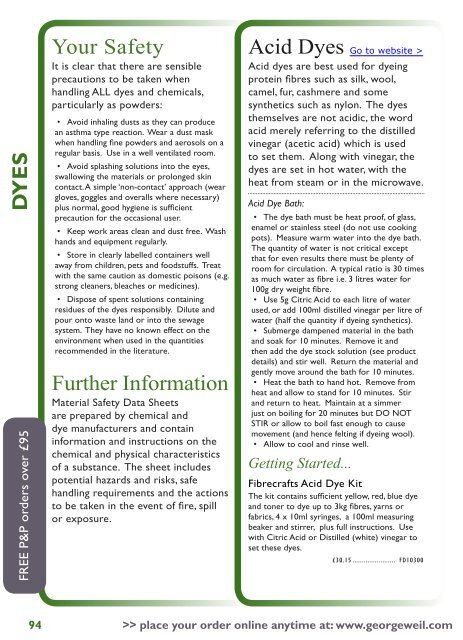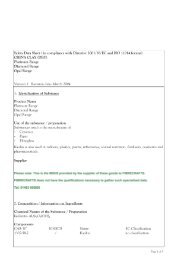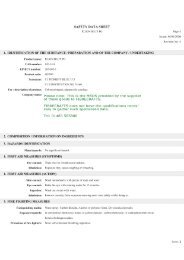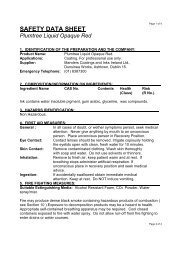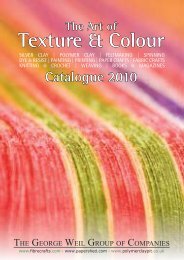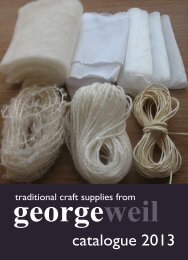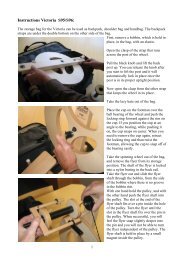You also want an ePaper? Increase the reach of your titles
YUMPU automatically turns print PDFs into web optimized ePapers that Google loves.
DYESFREE P&P orders over £95Your SafetyIt is clear that there are sensibleprecautions to be taken whenhandling ALL dyes and chemicals,particularly as powders:• Avoid inhaling dusts as they can producean asthma type reaction. Wear a dust maskwhen handling fine powders and aerosols on aregular basis. Use in a well ventilated room.• Avoid splashing solutions into the eyes,swallowing the materials or prolonged skincontact. A simple ‘non-contact’ approach (weargloves, goggles and overalls where necessary)plus normal, good hygiene is sufficientprecaution for the occasional user.• Keep work areas clean and dust free. Washhands and equipment regularly.• Store in clearly labelled containers wellaway from children, pets and foodstuffs. Treatwith the same caution as domestic poisons (e.g.strong cleaners, bleaches or medicines).• Dispose of spent solutions containingresidues of the dyes responsibly. Dilute andpour onto waste land or into the sewagesystem. They have no known effect on theenvironment when used in the quantitiesrecommended in the literature.Further InformationMaterial Safety Data Sheetsare prepared by chemical anddye manufacturers and containinformation and instructions on thechemical and physical characteristicsof a substance. The sheet includespotential hazards and risks, safehandling requirements and the actionsto be taken in the event of fire, spillor exposure.Acid Dyes Go to website >Acid dyes are best used for dyeingprotein fibres such as silk, wool,camel, fur, cashmere and somesynthetics such as nylon. The dyesthemselves are not acidic, the wordacid merely referring to the distilledvinegar (acetic acid) which is usedto set them. Along with vinegar, thedyes are set in hot water, with theheat from steam or in the microwave.Acid Dye Bath:• The dye bath must be heat proof, of glass,enamel or stainless steel (do not use cookingpots). Measure warm water into the dye bath.The quantity of water is not critical exceptthat for even results there must be plenty ofroom for circulation. A typical ratio is 30 timesas much water as fibre i.e. 3 litres water for100g dry weight fibre.• Use 5g Citric Acid to each litre of waterused, or add 100ml distilled vinegar per litre ofwater (half the quantity if dyeing synthetics).• Submerge dampened material in the bathand soak for 10 minutes. Remove it andthen add the dye stock solution (see productdetails) and stir well. Return the material andgently move around the bath for 10 minutes.• Heat the bath to hand hot. Remove fromheat and allow to stand for 10 minutes. Stirand return to heat. Maintain at a simmerjust on boiling for 20 minutes but DO NOTSTIR or allow to boil fast enough to causemovement (and hence felting if dyeing wool).• Allow to cool and rinse well.Getting Started...Fibrecrafts Acid Dye KitThe kit contains sufficient yellow, red, blue dyeand toner to dye up to 3kg fibres, yarns orfabrics, 4 x 10ml syringes, a 100ml measuringbeaker and stirrer, plus full instructions. Usewith Citric Acid or Distilled (white) vinegar toset these dyes.£30.15 ....................... FD1030094>> place your order online anytime at: www.georgeweil.com


